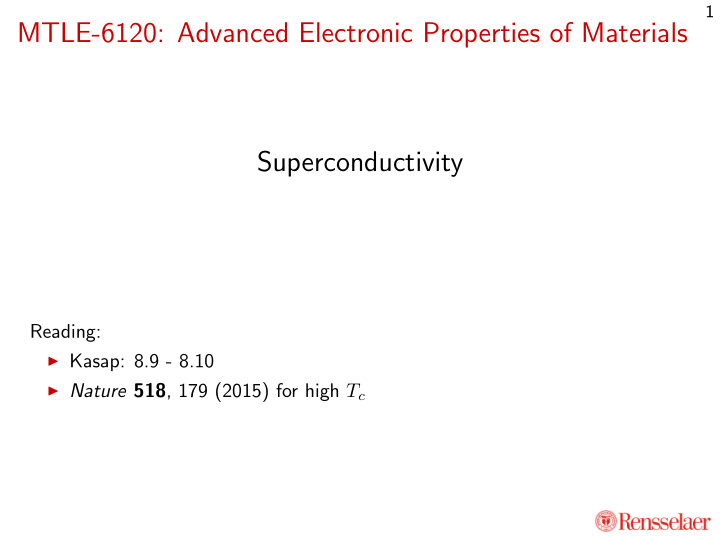



1 MTLE-6120: Advanced Electronic Properties of Materials Superconductivity Reading: ◮ Kasap: 8.9 - 8.10 ◮ Nature 518 , 179 (2015) for high T c
2 Zero resistance ◮ Many metals exhibit zero resistance below a temperature T c ◮ First discovered in 1911 in mercury ( T c = 4 . 2 K) ◮ Poorer conductors are usually better superconductors (higher T c ) ◮ Gold, copper and silver have negligible T c ◮ Highest among pure metals: lead ( T c = 7 . 2 K) and niobium ( T c = 9 . 3 K)
3 Meissner effect ◮ Superconductor � = perfect conductor ◮ Perfect conductor permits magentic fields (like normal metal) ◮ Superconductor expels magentic field completely ◮ Meissner effect: perfect diamagnetism χ m = − 1 ◮ Typical paramagnetic or diamagnetic metals, | χ m | ∼ 10 − 6 − 10 − 4
4 Critical fields ◮ Perfect diamagnet up to a maximum field H c ◮ Two types of behavior possible beyond H c ◮ Type I: Abrupt transition to normal state ρ � = 0 , χ m ∼ 0 ◮ Type II: gradual reduction of | χ m | → 0 (with ρ = 0 ) ◮ Mixed state of ρ = 0 and χ m > − 1 ranges from lower critical field H c 1 to upper critical field H c 2
5 Critical fields: T dependence ◮ Critical field decreases with temperature (exactly like ferromagnets) ◮ Higher critical field correlated with higher T c ◮ Upper and lower critical fields vanish together at T c for type II (no T c 1 and T c 2 )
6 Mixed state: vortices ◮ Field enters superconductor in domains: vortices ◮ Normal state inside, and superconducting (SC) state outside 2 e ≈ 2 × 10 − 15 Tm 2 in each vortex ◮ Quantum of flux Φ 0 = h ◮ Increasing density of vortices between H c 1 and H c 2 ◮ At H c 2 , no SC region left ⇒ ρ � = 0
7 Critical current ◮ Beyond current density j c , switch to normal state ◮ Primary application of superconductors: high-field magnets ◮ T , j and H ( B ) all push SC to normal state ◮ Limiting magnet performance limited by critical surface ◮ For metals and alloys, j c and H c increase with T c ◮ Not generally true for high- T c materials
8 Microscopic origins: e-ph interactions ◮ One electron distorts the lattice (emits / absorbs a phonon) ◮ This distortion reduces potential for second electron ◮ Attractive electron-electron interaction mediated by phonons ◮ Attraction − ∆ between electrons at k ↑ and − k ↓ ◮ All electrons near Fermi surface in Coooper pairs with energy reduced by ∆ ◮ Result: band gap ∆ near Fermi surface: no free electrons
9 Microscopic origins: BCS theory ◮ Attraction produces band gap ∆ ◮ But, pairs behave like spin zero particles with net charge 2 e ◮ Bosons: all pairs in same quantum state for T < T c ◮ Apply field, all pairs carry current together (coherently) ◮ Gap ∆ ⇒ no states to scatter into! ◮ Perfect conductor because of gap! ◮ Facilitated by e-ph interactions ⇒ resistive metals are better superconductors! ◮ Increase temperature: pairs break thermally ( T c ) ◮ Increase magentic field: imbalance in spin energies breaks pair ( H c ) ◮ Increase current density: pairs have enough momentum to scatter against electrons ( j c )
10 Microscopic origins: Type I vs Type II Two important length scales in superconductors 1. Coherence length ξ : length scale of the quantum wavefunction variation 2. Penetration depth λ : length scale of magnetic field variation ◮ When ξ > λ , cost of breaking wavefunction higher: stay SC till pairs break (Type I) ◮ When ξ < λ , break wavefunction to relax magnetic field energy ⇒ favorable to form vortices (Type II) ◮ Vortex: normal state extent ∼ ξ surrounded by field region ∼ λ
11 T c versus time ◮ Conventional metals with T c < 10 K and alloys with T c < 40 K ◮ New classes of materials with T c approaching 160 K!
12 Typical phase diagram of cuprate superconductors ◮ Correlated-electron materials: many poorly understood phases! ◮ Antiferromagnetism, spin-density waves and strange metals ◮ Strange metal: resistivity ∝ T even when λ < a ◮ d -wave superconductor: pairs have l = 2 instead of l = 0 (BCS)
13 Psuedogap: Fermi surface arcs ◮ No real superconducting gap ∆ ◮ Anisotropic gap in states with zero gap in certain directions ◮ Angular dependence of gap like a d -orbital ◮ Read Nature 518 , 179 (2015) for more!
Recommend
More recommend